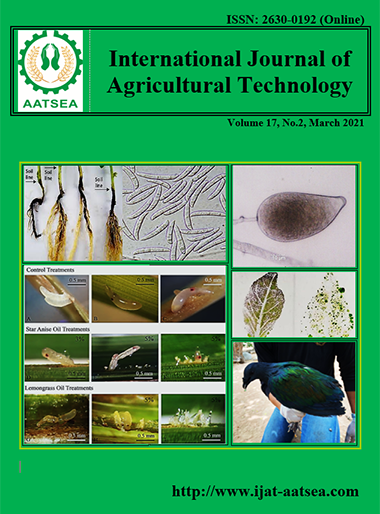Epitope-based peptide antigen of pepper yellow leaf curl Thailand virus for specific antibody production
Main Article Content
Abstract
Yellow leaf curl disease (YLCD) is one of the most devastating diseases causing significant yield loss to economic crops, especially peppers in Thailand. One of the reported causal agent is pepper yellow leaf curl Thailand virus (PepYLCTHV) which belongs to Begomovirus, Geminiviridae. Anti-PepYLCTHV antibody using peptide conjugate antigen was produced in this research. The peptide sequence was based on the virus coat protein sequences available in the GenBank database. Linear epitope sequences were analyzed using the IEDB program and compared to known, three-dimensional structures of African cassava mosaic virus. The synthesized peptide was conjugated with bovine serum albumin (BSA) and ovalbumin (OVA). Peptide-BSA conjugate was immunized into a New Zealand White rabbit with complete adjuvant in the first week and with incomplete adjuvant in the third week. The antiserum was collected for 12 weeks and the highest titer at 409,600, determined by indirect plate-trapped antigen enzyme-linked immunosorbent assay, was obtained. Characterization of the produced antibody showed specificity to PepYLCTHV and one more begomovirus, tomato leaf curl New Delhi virus, without cross reaction with 31 other viruses tested. Although the antibody had limited sensitivity, development of serological techniques using this antibody demonstrated good results for dot immunobinding assay and tissue print-immunoblotting. This is the first report of antibody production for PepYLCTHV using peptide antigen which can be further applied for virus detection
Article Details

This work is licensed under a Creative Commons Attribution-NonCommercial-NoDerivatives 4.0 International License.
References
Brown, J. K., Fauquet, C. M., Briddon, R. W., Zerbini, M., Moriones, E. and Navas-Castillo, J. (2012). Geminiviridae. In: King AMQ, Adams MJ, Carstens EB and Lefkowitz EJ (eds.) Virus Taxonomy: the Ninth Report of the International Committee on Taxonomy of Viruses. Elsevier-Academic Press, Amsterdam, the Netherlands, pp.351-373.
Charoenvilaisiri, S., Seepiban, C., Phironrit, N., Phuangrat, B., Yoohat, K. Deeto, R., Chatchawankanphanich, O. and Gajanandana, O. (2020). Occurrence and distribution of begomoviruses infecting tomatoes, peppers and cucurbits in Thailand. Crop Protection, 127:1-13.
Chiemsombat, P., Srikamphung, B. and Yule, S. (2018). Begomoviruses associated to pepper yellow leaf curl disease in Thailand. Journal of Agricultural Research, 3:1-11.
Doyle, J. J. and Doyle, J. L. (1990). Isolation of plant DNA from fresh tissue. Focus, 12:13.
Hancock, D. C. and O’Reilly, N. J. (2005). Synthetic peptides as antigens for antibody production. Methods in Molecular Biology, 295:13-26.
Hawkes, R., Niday, E. and Gordon, J. (1982). A dot-immunobinding assay for monoclonal and other antibodies. Analytical Biochemistry, 119:142-147.
Hidayat, S. H., Haryadi, D. and Nurhayati, E. (2009). Use of serological assay for the detection of pepper yellow leaf curl Indonesia virus. The Plant Pathology Journal, 25:328-332.
Hipp, K., Grimm, C., Jeske H. and Bottche, B. (2017). Near-Atomic resolution structure of a plant geminivirus determined by electron cryomicroscopy. Structure, 25:1-7.
Hongprayoon, R. (2015). Serological techniques for plant disease diagnosis. Phet Kasem Printing Group, Nakhon Pathom, Thailand. 88 p.
Hulo, C., Castro, E. D., Masson, P., Bougueleret, L., Bairoch, A., Xenarios, I. and Mercier, P. L. (2011). ViralZone: A knowledge resource to understand virus diversity. Nucleic Acids Research, 39:D576-D582.
Jespersen, M. C., Peters, B., Nielsen, M., and Marcatili, P. (2017). BepiPred-2.0: improving sequence-based B-cell epitope prediction using conformational epitopes. Nucleic Acids Research 45:24–29.
Kaufmann, A., Koenig, R. and Lesemann, D. E. (1992). Tissue print-immunoblotting reveals an uneven distribution of beet necrotic yellow vein and beet soil-borne viruses in sugarbeets. Archives of Virology 126:329-335.
Kenyon, L., Tsai, W. S., Shih, S. L. and Lee, L. M. (2014). Emergence and diversity of begomoviruses infecting solanaceous crops in East and South East Asia. Virus Research, 186:104-113.
Khan, J. A and Dijkstra, J. (eds.). (2002). Plant Viruses as Molecular Pathogens. The Haworth Press, Inc., New York.
Laemmli, U. K. (1970). Cleavage of structural protein during the assembly of the head of bacteriophage T4. Nature, 227:680-685.
Lawrence, K., Tsai, W. S., Shih, S. L. and Lee, L. M. (2014). Emergence and diversity of begomoviruses infecting solanaceous crops in East and South East Asia. Virus Research, 186:104-113.
Malichan, S., Taweechotworakul, P. and Hongprayoon, R. (2019). Detection of begomoviruses causing pepper yellow leaf curl disease in Thailand using broad-spectrum primers. Thai Journal of Agricultural Science, 37:250-264.
Padidam, M., Beachy, R. N. and Fauquet, C. (1995). Classification and identification of geminiviruses using sequence comparison. Journal of General Virology, 76:249-263.
Prospec Protein Specialist (2020). Viral antigens. Retrieved from https://www.prospecbio.com/viral_antigens.
Sakata, J. J., Shibuya, Y., Sharma, P. and Ikegami, M. (2008). Strains of a new bipartite begomovirus, pepper yellow leaf curl Indonesia virus, in leaf-curl-diseased tomato and yellow-vein-diseased ageratum in Indonesia. Archives of Virology, 153:2307-2313.
Sambrook, J., Fritsch, E. F. and Maniatis, T. (1989). Molecular cloning: a laboratory manual. Cold Spring Harbor Laboratory, Cold Spring Harbor, New York, USA.
Srithongchai, W., Adthalungrong, A., Kumcha, A. and Sukket, S. (2010). Pest management for yellow leaf curl disease on chili. Plant Protection Research and Development Office, Retrieved from http://www.doa.go.th/research/showthread.php?tid=764.
Trisno, J., Hidayat, S., Habazar, T., Manti, I. and Jamsari, A. (2009). Detection and sequence diversity of begomovirus associated with yellow leaf curl disease of pepper (Capsicum annuum) in West Sumatra, Indonesia. Microbiology Indonesia, 3:56-61.
Wang, T., Wang, D. and Lyu, Y. (2018). Construction of a high-efficiency cloning system using the Golden Gate method and I-SceI endonuclease for targeted gene replacement in Bacillus anthracis. Journal of Biotechnology, 271:8-16.
Xie, Y., Jiao, X., Zhou, X., Liu, H., Ni, Y. and Wu, J. (2013). Highly sensitive serological methods for detecting tomato yellow leaf curl virus in tomato plants and whiteflies. Virology Journal, 10:1-9.


